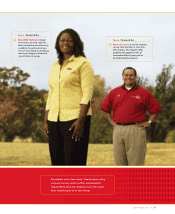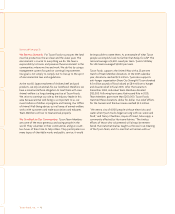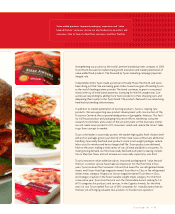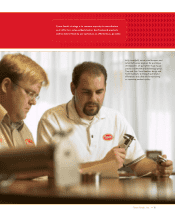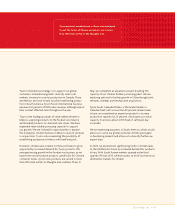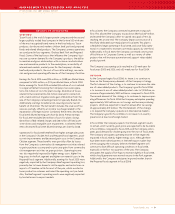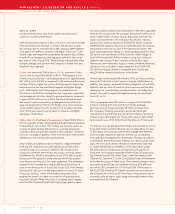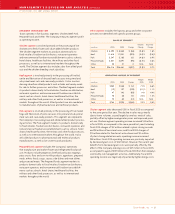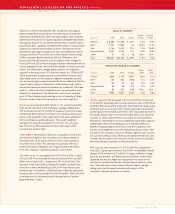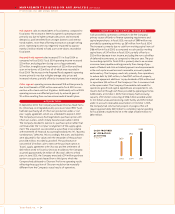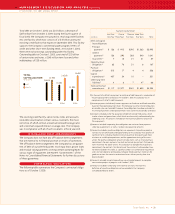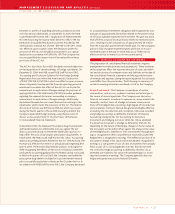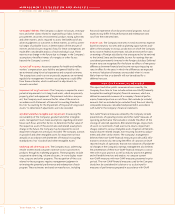Tyson Foods 2005 Annual Report Download - page 21
Download and view the complete annual report
Please find page 21 of the 2005 Tyson Foods annual report below. You can navigate through the pages in the report by either clicking on the pages listed below, or by using the keyword search tool below to find specific information within the annual report.
>> MANAGEMENT’S DISCUSSION AND ANALYSIS
TYSON FOODS, INC. 2005 ANNUAL REPORT
>>>>>>>>>>>>>>>>
>>>>>>>>>>>>>>>>
Tyson Foods, Inc. >> 19
RESULTS OF OPERATIONS
OVERVIEW
Tyson Foods is the world’s largest protein company and the second
largest publicly traded food company in the Fortune 500 with one
of the most recognized brand names in the food industry. Tyson
produces, distributes and markets chicken, beef, pork and prepared
foods and related allied products. The Company’s primary operations
are conducted in four segments: Chicken, Beef, Pork and Prepared
Foods. Some of the key factors that influence the Company’s busi-
ness are customer demand for the Company’s products, the ability
to maintain and grow relationships with customers and introduce
new and innovative products to the marketplace, accessibility of
international markets, market prices for the Company’s chicken,
beef and pork products, the cost of live cattle and hogs, raw mate-
rials and grain and operating efficiencies of the Company’s facilities.
Earnings for fiscal 2005 were $353 million, or $0.99 per diluted share,
compared to $403 million, or $1.13 per diluted share, in fiscal 2004.
Pretax earnings for fiscal 2005 included $33 million of costs related
to a legal settlement involving the Company’s live swine opera-
tions, $14 million of costs for plant closings, $8 million of losses
related to Hurricane Katrina, $12 million received in connection
with vitamin antitrust litigation and a gain of $8 million from the
sale of the Company’s remaining interest in Specialty Brands, Inc.
Additionally, earnings included a non-recurring income tax net
benefit of $15 million. The net benefit includes the reversal of tax
reserves, partially offset by an income tax charge related to the
repatriation of foreign income. Combined, these items decreased
fiscal 2005 diluted earnings per share by $0.02. Pretax earnings
for fiscal 2004 included $40 million of costs for plant closings,
$61 million of BSE-related charges and $46 million of fixed asset
write-downs and intangible asset impairments. Combined, these
items decreased fiscal 2004 diluted earnings per share by $0.26.
Operations for fiscal 2005 benefited from higher average sales prices
in the Company’s Chicken, Pork and Prepared Food segments, prod-
uct mix improvements and decreased grain costs in the Company’s
Chicken segment. These benefits were partially offset by losses
from the Company’s commodity risk management activities related
to grain purchases as compared to prior year gains from commodity
risk management activities on grain positions. Operating income
was also negatively impacted by higher energy costs, higher live
hog prices in the Pork segment and higher raw material costs in the
Prepared Foods segment. Additionally, earnings for fiscal 2005 were
negatively impacted by the Company’s Beef segment operating loss,
primarily due to lower domestic cattle supplies and restrictions on
imports of Canadian cattle for most of the year, which resulted in
lower production volumes and raised the operating cost per head.
Also, the Beef segment’s operating results were negatively impacted
by limited access to export markets.
In fiscal 2005, the Company continued to generate strong cash
flow. This allowed the Company to pay down debt by $367 million,
and exceed the Company’s debt-to-capital ratio goal of 40% by
reaching 39% at year end. The Company began construction of a
third fully dedicated case-ready plant in fiscal 2005. This plant is
scheduled to begin operating in fiscal 2006, and once fully opera-
tional, it is expected to increase case-ready capacity by one-third.
Additionally, in fiscal 2005, the Company continued construction
of facilities at its Corporate Center, as well as a variety of other
projects that will increase automation and support value-added
product growth.
The Company’s accounting cycle resulted in a 52-week year for
fiscal years 2005 and 2003, and a 53-week year for fiscal 2004.
OUTLOOK
As the Company begins fiscal 2006, its intent is to continue to
focus on the three primary elements of the Company’s strategy.
The first element of the strategy is to continue to increase the sales
mix of value-added products. The Company’s goal for fiscal 2006
is to increase its mix of value-added product sales to $12 billion, an
increase of approximately $900 million as compared to fiscal 2005.
The second element of the strategy is to continue to improve oper-
ating efficiencies. For fiscal 2006, the Company anticipates spending
approximately $232 million on cost savings and income producing
projects, which are expected to result in annual after tax savings
of approximately $72 million. The third element of the strategy
is to expand the Company’s presence in international markets.
The Company’s goal for fiscal 2006 is to increase its in-country
presence in at least one foreign market.
In fiscal 2006, the Company expects the Chicken segment results
to remain solid. Currently, grain prices are expected to be favorable
in fiscal 2006 as compared to fiscal 2005, and the Company antici-
pates good demand for chicken going into the start of fiscal 2006.
The Company anticipates operating income will be negatively
impacted in fiscal 2006 by higher energy costs. Although there
have been recent developments in the beef export market that
are encouraging, the Company believes the Beef segment will
continue to face difficult operating conditions in fiscal 2006,
especially in the first two quarters of the year. The Company
anticipates the supply of live hogs to increase slightly in fiscal 2006,
which should generate more normal returns in the Pork segment.
Additionally, the Company anticipates improved market share in
the Prepared Foods segment in fiscal 2006.


